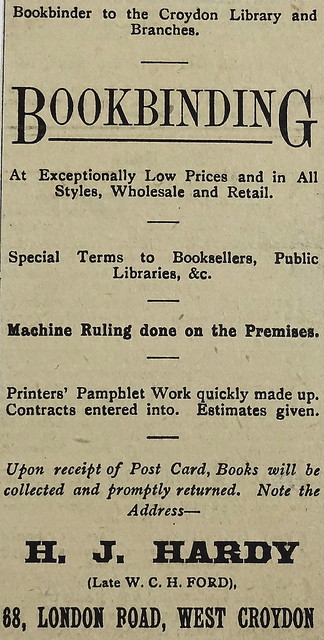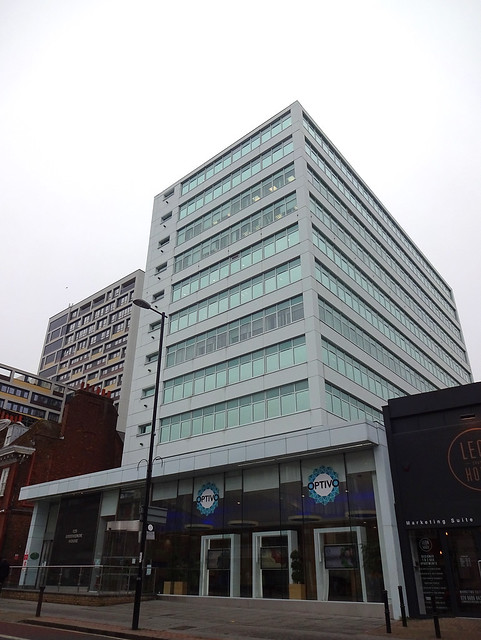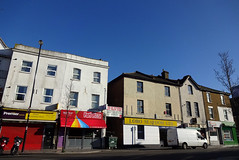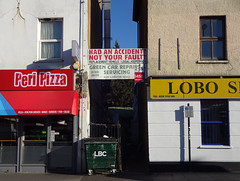As noted in my last article, 188–190 London Road is currently a fishmongers called Lobo Seafood. In that article, I described the history of number 188 up to the point where 188 and 190 were joined into one; here I discuss the history of number 190, including events after it was amalgamated with its neighbour, right up to the present day.
Warning: photo below that at least two people with vertigo have found problematic due to the lines of the building.
1860s–1870s: Construction of the building
As described in my previous article, 190 London Road was built around 1869–1870 as a shop with living accommodation consisting of five bedrooms, a parlour, and a kitchen. It had two workshops behind the main premises; a “large brick built and slated” one butting directly on to the house, and another comprising an outbuilding at the end of its garden.[1]
1870s: G H Rolls
In comparison to the initially somewhat volatile situation at number 188, number 190 — then known as 4 Kidderminster Terrace — had a slower but more stable start to life. The first documented occupant was G H Rolls, a printer and bookbinder who boasted of being able to bind musical scores “to open perfectly Flat”. In place by early 1874, G H Rolls remained until around the end of the decade.[2]
![Advert offering “Books Bound and Lettered with real Gold Leaf” in “Large workshops [...] in the rear of my premises fitted up with Modern Improvements and special facilities for executing every description of Bookbinding at exceptionally low prices”.](/history/images/0190/w-c-h-ford-ad-1893-640px.jpg)
1880s–1890s: William Charles Huxtable Ford
G H Rolls’ replacement was even more long-lasting. William Charles Huxtable Ford took over the printing and bookbinding business by Spring 1880, and remained until just past the turn of the century.[3]
William pitched his firm as one that was both long-established and bang up to date, advertising his “steam works” as having “large workshops [...] fitted up with modern improvements” but taking care to describe the business as “The Old Established Croydon Bookbinder”.[4]
After leaving London Road, William moved around the corner to a newly-built house at 41 Kidderminster Road. He may have left the business due to poor health, as he died on 11 October 1905 at the age of just 53.[5]

1900s–1970s: H J Hardy
The next occupant of 190 London Road was also a bookbinder, and the longest-lasting of them all. Indeed, it seems possible that Herbert James Hardy had previously been employed by William, and took over the business from him. In any case, by the beginning of 1902 Herbert was in charge of the business now known as H J Hardy.[6]
At some point during the tenure of H J Hardy, the workshop at the back of the property was extended further backwards, leaving just a narrow passage between it and the additional workshop which had originally been at the end of number 190’s garden.[7]
The business was converted to a limited company during the 1950s, and remained at 190 London Road until the early 1970s. It then moved to 115 Southbridge Road and again to 19 Imperial Way, where it remained until the late 1980s.[8]
It’s unclear how long Herbert himself was involved with the business — certainly not for its entire time on London Road, since he was born in 1873 and is unlikely to have still been working at the age of 100. He was certainly still alive and living on Briar Road, Norbury, in August 1942, when he was granted probate on his wife Annie’s estate, but after this he vanishes from the documentary record.[9]
1970s: Amalgamation of 188 and 190, and the arrival of accountants
The amalgamation of 188 and 190 London Road into the double-width property of today seems to have taken place shortly after the departure of A & P Stallion from number 188 and H J Hardy Ltd from number 190. This may have initially been an informal arrangement, as the index cards for the property at Croydon Council’s planning department have no record of an application for internal alterations.
Nevertheless, by mid-1974 at least one of the properties was occupied by chartered accountants Boty Cox Crawford & Ridley, and by the end of the year the company was claiming 188–192 London Road as its address and applying for planning permission to demolish the workshop behind its premises and replace it with a two-storey office building.[10]
By the start of 1976, Boty Cox Crawford & Ridley had been either replaced by or absorbed into Edward Moore & Sons, a national firm of accountants which was originally founded on Leadenhall Street in 1866 and expanded throughout England and Scotland in the 1970s.[11] Edward Moore & Sons also seems to have been interested in expansion in a more local sense, as in late 1979 it applied for planning permission to build additional offices at the side of its London Road premises.[12] Although permission was granted, this proposal was never actually put into action, and by early 1981 the firm had left London Road and moved a short distance away to Bedford Park.[13]
1980s–2000s: Consulting engineers
Next to arrive at 188–190 London Road was a firm of consulting engineers known as Bullen & Partners. Previously based at Grosvenor House on Croydon High Street, the firm arrived on London Road by May 1983 and remained until at least late 1988. At some point Bullen & Partners also opened an office at Vistec House a little further up the road, and they kept this on after leaving numbers 188–190, remaining there until around 2005–2006.[14]
By the mid-1990s Bullen & Partners had been replaced at 188–190 London Road by another firm of consulting engineers, Austen Associates, which moved here from 45 Coombe Road in South Croydon after the retirement of managing director Reg Austen. With the lease at Coombe Road coming to an end, the remaining partners decided to buy a freehold property and settled on London Road.[15]
In line with Reg Austen’s previous employment with the South East Thames Regional Health Authority, Austen Associates specialised in healthcare projects, including work for the NHS. The company took on projects of all sizes, with a focus on the design of building services such as heating, ventilation, air conditioning, water, gas, medical gases, power, lighting, and fire alarms.
During the years after the move to London Road, changes in the market and the expansion of the private finance initiative for NHS projects led to a substantial decrease in the company’s main source of work, and redundancies and resignations soon followed. By the end of 2001 Austen Associates had left London Road and moved to Edenbridge, Kent.[16]
2002–present: Fishmongers
Next to arrive at 188–190 London Road was Lobo Seafood, a chain of fishmongers with several other branches around London and Birmingham.[17] Originally founded in 1990 as an importer and wholesaler of frozen fish based in Billingsgate Market, in 1997 the company expanded into retail with the opening of a fishmonger’s shop in Peckham, and it later also opened a number of butchers’ shops.[18]
The London Road branch opened in 2002 and remains there today, selling frozen fish and seafood including tilapia, kingfish, red snapper, shark, croaker, hake, herring, sprats, squid, prawns, and mussels. It also sells a small selection of West African groceries such as palm oil and canned beans, as well as a few meats such as turkey wings and smoked chicken.[19]
Thanks to: Aloysius Lobo; Lee Thompson; the Planning Technical Support Team at Croydon Council; the staff, volunteers, and patrons at the Museum of Croydon; and my beta-readers Fred and Kat. Census data and non-Croydon phone books consulted via Ancestry.co.uk.
Footnotes and references
- Information on living accommodation and workshops is taken from an advert on the front page of the 27 November 1880 Croydon Guardian. A view of the workshop layout can be seen on the 1896 Ordnance Survey map sheet London XV.94 via the National Library of Scotland. The buildings running north from the junction with Kidderminster Road are, respectively, numbers 182–184, 186, 188, 190, 202, and 204 London Road. The alleyway between numbers 190 and 202 gives access to number 190’s additional workshop (the L-shaped building behind numbers 188 and 190).
- 4 Kidderminster Terrace does not appear explicitly in Wilkins’ 1872–73 directory, suggesting that the premises were vacant. Ward’s directories list G H Rolls, bookbinder, in 1874 and 1876; G H Rolls, bookbinder and printer, in 1878; and W C H Ford, bookbinder and printer, in 1880. An advert on page 4 of the 22 November 1879 Croydon Chronicle offers a house and shop to let, with application to be made to “G. H. Rolls, Kidderminster-terrace, London-road, Croydon”, suggesting that Mr Rolls remained on London Road until around that time. Quotation re musical scores is taken from an advert in Atwood’s 1878 directory, reproduced here.
- Ward’s directories list W C H Ford, bookbinder and printer, from 1880 to 1901 inclusive (see earlier footnote for evidence on date of publication of the 1880 edition). Kelly’s 1889 directory gives his full name as William Charles Huxtable Ford.
- Quotations taken from an advert in the 7 January 1893 Croydon Guardian, found as a clipping in the firms files at the Museum of Croydon and reproduced here.
- Ward’s 1902 directory lists William at 41 Kidderminster Road, on the north side between the junction with London Road and the junction with Nova Road (Nova Road also has a junction with London Road, but curves round at its end to meet Kidderminster Road). The 1901 edition has this area as “Building land”. William’s date of death is taken from his entry in the National Probate Calendar, and his age at death is taken from his entry in the Civil Registration Death Index.
- Ward’s directories list Herbert J Hardy from 1902 right up to the final edition of 1939 (as a bookbinder and printer up to 1908, a bookbinder and ruler from 1909 to 1932, and just a bookbinder thereafter). It seems clear from the 1904 advert reproduced here that the business was known as “H J Hardy” rather than “Herbert J Hardy”. Herbert’s full middle name is taken from the 1911 census, which lists him and his family at 2 Kilmartin Avenue, Norbury. The 1901 census lists him on Frant Road as a 28-year-old “Bookbinders Manager” working for an employer, and as this is just before William passed the business on to him, it certainly suggests that the employer might have been William himself.
- Extension of the workshop is deduced from a comparison of the 1913 and 1955 Ordnance Survey maps (both available at the Museum of Croydon; sheets XIV.6 and TQ3166 respectively, 1:2500 scale).
- Croydon phone books list H J Hardy, bookbinder and ruler, at 190 London Road up to and including 1959; and then H J Hardy Ltd, bookbinders, at 190 London Road up to and including 1973; at 115 Southbridge Road up to and including 1979; and at 19 Imperial Way up to and including 1988. No H J Hardy is present in the 1990 edition.
- Herbert’s year of birth is taken from the 1939 Register of England and Wales, which lists him and Annie on Briar Road, Norbury. For evidence on Herbert still being alive in August 1942, see Annie’s entry in the National Probate Calendar. I haven’t been able to find Herbert’s own date of death. He had departed Briar Road by the time of the 1945 electoral register, but since these registers are indexed by street instead of surname it’s not possible to find an individual without going through every entry, and phone books throughout the 1940s list only the business address of H J Hardy on London Road. He may have died, or simply moved away.
- The July 1974 Croydon phone book lists Boty Cox Crawford & Ridley, “Chrtd Acctnts”, at 188 London Road. A planning application by Boty Cox Crawford & Ridley, 188–192 London Road, for “Extension to offices” including “Demolition of exising workshop” and “Extinguishing of present industrial use” was granted on 3 April 1975 (ref 74/20/2224, viewed on microfiche at Croydon Council offices). Although the surviving records at Croydon Council offices do not record the date this application was made, its reference number indicates it was deposited in 1974. A later application (ref 79/20/1792) states that this permission was taken up and completed: “A two storey extension had been added to 194 in 1975”.
Phone books list Edward Moore & Sons at 188 London Road in the January 1976 edition, and at 190 London Road from the July 1977 Croydon edition to the October 1980 Bromley/Orpington edition inclusive. Brian Gittings’ 1980 survey of central Croydon gives an address of 188–192 for the company, though it isn’t clear whether this was from guesswork or from numbering on the frontage.
Background information on Edward Moore & Sons is taken from the London Metropolitan Archives records for Moores Rowland predecessors (ref CLC/B/162). The LinkedIn page of former Edward Moore & Sons manager Robin Colmer confirms that the company did have an office in Croydon around this time. Regarding the question of whether it took over or replaced Boty Cox Crawford & Ridley, I have little evidence either way, except that the latter company is entirely absent from the January 1976 Croydon phone book (it could of course have moved elsewhere outside Croydon). The aforementioned London Metropolitan Archives records do state that “Edward Moore and Sons amalgamated with a number of practices in the 1970s and 1980s”.
- A planning application deposited on 6 September 1979 by Edward Moore & Sons for “Office infill between Nos. 190 and 202 London Road” to replace the existing “Vehicular access” gives an address of 188–194 London Road (ref 79/20/1824). According to the Council officer’s report, this application was a “modest proposal” to erect “two floors of offices [...] at first and second floor level, over what is to become a pedestrian access”.
- The extension was to be built over the alleyway that runs eastwards from London Road between number 190 and number 202. No such extension exists today, nor does any sign that there ever was one. I’ll discuss this alleyway and what it leads to in my next article. The February 1981 Croydon phone book lists Edward Moore & Sons on Bedford Park, which is around 650 metres away from 188–190 London Road as the crow flies.
- Phone books list Bullen & Partners at Grosvenor House, Croydon High Street, up to and including the 1982 Croydon edition; at 188 London Road from the May 1983 Caterham edition to the 1988 Croydon edition inclusive; and at Vistec House, 185 London Road from the 1990 Croydon edition to the 2005–2006 Croydon edition inclusive. From 1988 onwards a company called Bullen Consultants is also listed at the same address as Bullen & Partners. There was definitely some overlap between the offices at 188 London Road and Vistec House, and the company were certainly still in occupation of number 188 as of December 1988; a letter from G T Williams of Bullen & Partners, dated 6 December 1988, in support of a planning application (ref 88/3295/P) for Zodiac House, states that “As an employer with an office opposite the proposed site and a second alongside (Vistec House) I am in favour of development of the area”.
- Croydon phone books list Austen Associates at 45 Coombe Road up to and including February 1992, at 188 London Road from July 1993 to January 2001 inclusive, and with no address but the same phone number they had at 188 London Road in 2002. Information about the retirement of Reg Austen, the end of the lease at Coombe Road, and the decision to buy the freehold of 188–190 London Road was provided by Lee Thompson, who worked for Austen Associates from 1984 to 1997 (via email, 9 January 2019). Lee told me that he couldn’t remember the exact date of the move to London Road, but thought it might have been around 1989–1990. He also said that due to increased staff numbers in the late 1980s the company rented additional office space in Leon House, which again was given up when they moved to London Road.
- All information in this and the preceding paragraph was supplied by Lee Thompson (via email, 9 January 2019), aside from the date of leaving London Road and the destination of Edenbridge, both of which are taken from an application to Companies House to change Austen Associates’ registered office to 139A Edenbridge High Street (viewed on the Companies House website, from which it has since been deleted; see also phone book evidence in earlier footnote).
- As of January 2019, the list of branches on Lobo’s website includes shops in Birmingham, Croydon, Dalston, Deptford, Edmonton, Harlesden, Peckham, Shepherd's Bush, and Upton Park, as well as a shop and stand in Billingsgate Market. Google Street View images provide evidence for many of these branches having existed for at least around a decade at the time of writing, showing Lobo at 188–190 London Road in September 2008; at 62 Deptford High Street in June 2008; at 262 Fore Street in August 2008 (with the shutter down, but the July 2012 capture shows it open); at 63 Kingsland High Street in June 2008 (again with the shutter down, but the August 2011 capture shows it open); at 13 Harlesden High Street in July 2012; and at 213 Rye Lane, Peckham, in August 2014 (and although the July 2008 capture shows the name “Seafood Superstore” rather than “Lobo”, it does also show “Lobo House” on the frontage above).
- Date of founding is taken from Lobo’s website. Opening date and location of the company’s first retail shop provided by Aloysius Lobo (via email, 9 January 2019). Information on the company’s expansion into butchery is from personal observation (for example, it had a halal butchers at 222-224 London Road until around 2015–2016, and I also have a photo of one on Deptford High Street, next to one of its fishmongers). According to Lobo’s entry on the Companies House website, it was initially incorporated in January 1991 under the name of Lacelin Ltd.
- Opening date of London Road branch provided by Aloysius Lobo (via email, 9 January 2019). Examples of items sold are from personal observation on a visit in February 2019.


